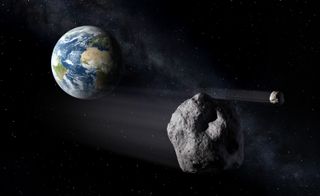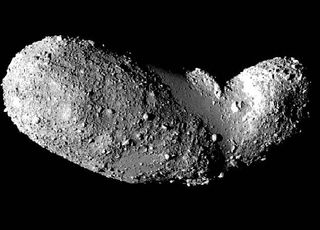
Humanity has the technical know-how to deflect a killer asteroid away from Earth, but whether the world can come together to pull it off in time is another matter.
A looming asteroid strike would be a global problem demanding a complex and coordinated response, experts say. Not only would nations need to set aside their differences and work together, but some would have to put their citizens at increased risk for the good of the planet, agreeing to allow the space rock to be steered in their direction from the predicted impact site.
"There are a million geopolitical questions that are really, really, really tough," said Rusty Schweickart, co-founder and chairman emeritus of the B612 Foundation, a nonprofit organization dedicated to helping protect Earth from asteroid strikes.
"We're going to solve the technology," added Schweickart, who was the lunar module pilot on NASA's Apollo 9 mission in 1969. "But to get a geopolitical decision made in a timely way, and not just debate all the way down until it's too late to act, is going to be a real challenge." [Gallery: Potentially Dangerous Asteroids]
A cosmic shooting gallery
Earth zooms around the sun in a cosmic shooting gallery, sharing space with millions of asteroids that slam into us from time to time.
The events of Feb. 15 provide a stark reminder of this ever-present danger. On that day, a 55-foot-wide (17 meters) space rock exploded without warning over the Russian city of Chelyabinsk, damaging thousands of buildings and wounding 1,200 people. Hours later, the 130-foot asteroid 2012 DA14 missed Earth by just 17,200 miles (27,700 kilometers), coming closer than the planet's ring of geosynchronous satellites
Get the Space.com Newsletter
Breaking space news, the latest updates on rocket launches, skywatching events and more!
While astronomers have spotted 95 percent of the 980 near-Earth asteroids at least 0.6 miles (1 km) wide, which might end civilization if they hit us, many smaller but still hazardous space rocks remain undetected.
Researchers have discovered less than 30 percent of the close-flying 330-foot-wide (100 m) objects, for example, which could destroy an area the size of a state if they hit us. And they've mapped out the orbits of less than 1 percent of the 130-footers thought to be out there, which could wipe out a city.
In all, just 9,700 near-Earth asteroids have been catalogued to date, out of a population numbering in the millions. Many astronomers and politicians are thus calling for more resources to be put toward asteroid-detection efforts, so that we have a better idea of what's headed our way in the future.
Something big will hit us again, experts say, and we'll probably need years or decades of warning to do something about it. [Meteor Explodes Over Russia (Video)]
How to deflect an asteroid
Scientists think they know ow to how to deflect an asteroid headed directly for Earth, given enough lead time.
The strategy involves mounting at least two coordinated space missions, Schweickart said. The first would slam a kinetic impactor into the asteroid to knock it off course. The second would launch a "gravity tractor" probe to fly alongside the space rock, nudging it farther via a tiny but persistent gravitational tug.
"You always need a gravity tractor there to ensure that any deflection does not end up having the asteroid go through a [gravitational] 'keyhole,' which would simply bring it back later," Schweickart told SPACE.com.
This approach can avert more than 98 percent of projected collisions, according to a 2008 report called "Asteroid Threats: A Call for Global Response." The report was put together by the Association of Space Explorers' International Panel on Asteroid Threat Mitigation, which Schweickart chaired. [Photos: Asteroids in Deep Space]
A different strategy — such as a nuclear blast — may be needed for asteroids more than 1,300 feet (400 m) wide, or for those detected with little warning time, the report adds. But such dire cases are likely to come along just once every 100,000 years or so.
Political hurdles
Humanity has successfully demonstrated both aspects of the impactor-tractor technique. In 2005, for example, NASA smashed a probe into the Comet Tempel 1 to investigate the icy body's composition. And several spacecraft, such as NASA's Dawn probe and Japan's Hayabusa craft, have rendezvoused with asteroids in deep space.
But the main challenges of an asteroid-deflection mission will probably be more political than technical, Schweickart said. And perhaps the biggest hurdle of all will be getting the world to agree which way to steer the asteroid.
Each incoming asteroid whose orbit has been mapped will threaten Earth along a specific "risk corridor" — a line of potential impact sites that extends about 180 degrees across the planet's surface but is just a few tens of kilometers wide.
A deflection campaign would not be able to make huge changes to the dangerous asteroid's orbit. Rather, it could merely drag the projected impact point along the risk corridor to the left or to the right, by slowing the space rock down or speeding it up slightly.
The goal, of course, would be to drag the impact site off the planet entirely. But determining how exactly to achieve this — to go left or right, to push the asteroid or to pull it — would be difficult, for any decision would necessarily put some nations at greater risk than others, Schweickart said.
"If you start a deflection and something goes wrong, you have now shifted that impact point along the risk corridor one way or the other," Schweickart said. "And now people are in danger who were not in danger before you started this operation."
And that's just one of many tricky geopolitical issues a potential asteroid-deflection mission would present, he added.
"Who does it? Who pays for it? Who handles the liability?" Schweickart said. "How does the decision get made? Do we deflect the 40-meter object, or do we evacuate? Who makes that decision? And who pays for the evacuation? Everybody, because we all collectively made the decision? Or do the people who were unlucky enough to evacuate have to handle the cost?"

Getting the ball rolling
Schweickart and many of his colleagues think it's imperative to develop an international framework for dealing with the asteroid threat, so that the world can work together to predict and prevent catastrophic impacts.
The Association of Space Explorers (ASE) — a group of veteran astronauts and cosmonauts — lays out a proposed framework in its 2008 report, calling for the United Nations to oversee a three-tiered program consisting of 1) an international asteroid detection and warning network; 2) a mission-planning group that would assess deflection options; and 3) a mission-authorization body tasked with developing "the policies and guidelines that represent the international will to respond to the global impact hazard."
The United Nations' Action Team on Near-Earth Objects — better known as Action Team 14 — embraced much of this plan in a set of recommendations it drew up late last year. These recommendations are likely to be adopted by the U.N.'s Working Group on Near-Earth Objects, then go up the chain from there, ASE officials said.
"Given the work methods of the [UN's] Committee on the Peaceful Uses of Outer Space, the recommendations of the Working Group will likely be adopted by the Committee in June," ASE officials wrote in a Feb. 27 update. "The [UN] General Assembly will likely follow suit in October without further discussions."
The U.N.'s ponderous pace and many layers of bureaucracy may be frustrating to scientists who have been working the technical side of the hazardous-asteroid problem for years. But Schweickart voiced optimism that the political progress made will eventually be worth the wait.
"When you get there, the whole world has bought into it," he said. "I mean, you're moving the whole world."
Follow Mike Wall on Twitter @michaeldwall. Follow us @Spacedotcom, Facebook or Google+. Originally published on SPACE.com.
Join our Space Forums to keep talking space on the latest missions, night sky and more! And if you have a news tip, correction or comment, let us know at: community@space.com.

Michael Wall is a Senior Space Writer with Space.com and joined the team in 2010. He primarily covers exoplanets, spaceflight and military space, but has been known to dabble in the space art beat. His book about the search for alien life, "Out There," was published on Nov. 13, 2018. Before becoming a science writer, Michael worked as a herpetologist and wildlife biologist. He has a Ph.D. in evolutionary biology from the University of Sydney, Australia, a bachelor's degree from the University of Arizona, and a graduate certificate in science writing from the University of California, Santa Cruz. To find out what his latest project is, you can follow Michael on Twitter.
